Effect of Environmental Parameters on Streamer Discharge in Short Air Gap between Rod and Plate
Abstract
:1. Introduction
2. Simulation Model of Air Streamer Discharge
2.1. Mathematical Model of Streamer Discharge
2.2. Selection of Discharge Parameters
2.3. Mesh Generation and Solution Method
3. Simulation Results and Analysis
3.1. Analysis of Streamer Discharge Simulation Results under Different Humidity
3.1.1. Electron Concentration
- (1)
- The essence of streamer discharge is the ionization process of a large number of gas molecules. The collision ionization of electrons and gas molecules is the most important ionization process in the process of streamer discharge. Electrons are the main carrier of energy transfer between electric field and particles. Electrons obtain energy from an electric field and then use the collision and scattering process with gas molecules to transfer energy to gas molecules. It can be seen that electrons play an important role in the process of streamer discharge. In the process of gas ionization, the generation rate of electrons is always greater than zero. With the development of discharge, more and more gas molecules are ionized, resulting in the gradual increase of electron density in the discharge region with the development of the streamer. The main area where gas molecules collide, ionize, and release electrons is the streamer head area, so the maximum electron generation rate appears in the streamer head area, and the electron concentration in the streamer head is high during the development of the streamer. It can also be seen that, although the generation of electrons mainly occurs at the streamer head, due to the positive discharge, the electrons generated at the streamer head will quickly move along the streamer channel to the positive needle electrode, resulting in a peak electron density near the surface of the needle electrode.
- (2)
- Comparing the electron concentration distribution under different humidity, it can be found that, at the same time, with the increase of humidity, the peak electron concentration increases slightly, and the forward distance of the streamer increases, that is, with the increase of humidity, the development speed of the streamer accelerates: Under dry clean air, the gap breakdown time is 16 ns; the breakdown time under 40% relative humidity is 15 ns, and the breakdown time under 80% relative humidity is 14.6 ns. This is because higher relative humidity means that the density of water molecules in the air increases, which increases the amount of collision ionization between electrons and water molecules in the air, so as to increase the ionization constant and promote the development of discharge. Although the increase of humidity also leads to the increase of the electron adhesion coefficient, which will hinder the development of discharge. The increase of ionization coefficient dominates in this range of humidity, resulting in more intense discharge with the increase of humidity.
3.1.2. Electric Field Intensity
- (1)
- In the positive needle negative plate streamer discharge structure, at the starting time or during the streamer development, the electrons formed at the streamer head migrate to the anode under the action of an electric field force; some electrons are neutralized at the anode surface, and the positive ions migrate to the negative electrode. However, the migration rate of positive ions is much lower than that of electrons, resulting in the shift of positive and negative charge centers in the discharge space, and the accumulation of a large number of positive ions in the region of the streamer head, resulting in the positive polarity of the streamer head. The accumulation of positive charges distorts the space electric field at the streamer head and intensifies the electric field at the streamer head. As shown in Figure 4, the electric field intensity reaches the maximum at the streamer head. It can also be seen that, during the development of the streamer, the area in front of the streamer head where no discharge occurs bears most of the voltage drop, while the medium voltage drop of the streamer channel is small. This is mainly because the streamer channel has a large number of positive and negative charges and is approximately electrically neutral, that is, the external charge density is almost zero, which can be approximately regarded as a plasma channel (low resistance). Therefore, the voltage drop in the streamer channel is small.
- (2)
- Comparing the field strength distribution under different humidity, it can be found that the maximum field strength at the streamer head increases slowly with the increase of humidity. The reasons are as follows: the increase of humidity means that there will be more water molecules or water vapor molecular clusters in the air. The existence of water vapor molecular clusters will lead to the distortion of the original spatial electric field distribution, and the electric field intensity around water molecular clusters will increase significantly, resulting in the increase of air ionization coefficient in local areas. The more water molecules, the greater the average ionization coefficient of the gas, the higher the probability of electron collision ionization, and the severity of discharge will be greatly increased. In the streamer discharge channel, the most intense gas discharge is the streamer head. Collision ionization will produce a large number of charged particles; electrons and negative ions will flow to the metal anode under the action of electric field force, and a large number of positive ions will stay in the streamer head, which will greatly strengthen the electric field strength of the streamer head. Moreover, the higher the humidity is, the more intense the discharge is and the more positive ions will stay in the streamer head, resulting in the greater electric field strength of the streamer head.
3.2. Analysis of Streamer Discharge Simulation Results under Different Pressure
3.2.1. Electron Concentration
- (1)
- Comparing the electron concentration profiles under different air pressures, it is found that, at the same time, the electron concentration decreases with the decrease of air pressure, and the decreasing trend is more obvious at low air pressure. From the perspective of the average free path of electrons, with the decrease of air pressure, the particle concentration in the air decreases as a whole, the number of particles per unit distance decreases, and the average free path of electrons increases, which leads to the greatly reduced probability of collision ionization caused by electrons per unit distance, that is, the collision ionization coefficient decreases. The frequency of electron positive ion recombination decreases with the decrease of electron collision probability, resulting in the decrease of the intensity of particle behavior in the electric field.
- (2)
- When the air pressure decreases, the streamer develops faster. Under the condition of low air pressure, the streamer can reach the negative electrode faster. At 9 ns, the streamer head at 70 kPa has reached the distance from the plate electrode, and the streamer head at 80 kPa is at 3.5 mm. At this time, the streamer head at standard atmospheric pressure is still about halfway because, with the increase of the average free path of the electron, the faster the movement speed of the electron and the greater the kinetic energy that can be accumulated in the electric field. After the collision of the streamer head, the electron can move forward at a faster speed, which has a greater distortion effect on the spatial electric field, resulting in the acceleration of the propagation speed of the streamer. The acceleration of electron movement will greatly reduce the probability of electron attachment and negative ions, which will be conducive to the formation of streamers. However, because collision ionization dominates the discharge intensity in streamer discharge, the increase of streamer discharge intensity caused by the decrease of adhesion coefficient is not obvious. Low pressure can reduce the intensity of streamer discharge, but it will accelerate the propagation speed of streamer in space electric field. According to the calculation, the air gap between rod and plate will be broken down after 9 ns of streamer at 70 kPa pressure, and the average forward speed of streamer is about 5.6 × 107 cm/s.
3.2.2. Electric Field Intensity
4. Experimental Study on Short Air Gap Breakdown Characteristics of Rod Plate under Different Environmental Parameters
4.1. Test Equipment and Test Methods
4.1.1. Test Device
4.1.2. Test Method and Process
4.2. Test Result
4.3. Analysis and Discussion
5. Conclusions
- (1)
- At lower humidity (relative humidity <80%), with the increase of humidity, the electron density of the streamer channel increases, the field strength of the streamer head increases, the development speed of the streamer increases, and the gap breakdown voltage decreases. At higher humidity (relative humidity >80%), with the increase of humidity, the electron density of the streamer channel decreases, the field strength of the streamer head decreases, the development speed of the streamer slows down, and the gap breakdown voltage increases.
- (2)
- With the decrease of air pressure, the electron density of the streamer channel decreases, the field strength of the streamer head decreases, the development speed of the streamer accelerates, and the gap breakdown voltage decreases.
- (3)
- The temperature change has little effect on the streamer development process and gap breakdown voltage.
Author Contributions
Funding
Institutional Review Board Statement
Informed Consent Statement
Data Availability Statement
Acknowledgments
Conflicts of Interest
References
- Wan, Q.; Huo, F.; Xie, L.; Liu, Y.; Xu, T. Summary of research on flashover characteristics of long air gaps. High Volt. Eng. 2012, 38, 2499–2505. [Google Scholar]
- Chen, W.; Ceng, R.; He, H. Research progress of long air gap discharge. High Volt. Eng. 2013, 39, 1281–1295. [Google Scholar]
- Liu, C.; Zhou, X.; Zhuang, C. Experimental observation of UHV scale real engineering gap operation impulse discharge under two kinds of humidity. Trans. China Electrotech. Soc. 2019, 34, 2239–2246. [Google Scholar]
- Zheng, Y.; Ren, J.; Shu, S. Effect of air humidity on short gap breakdown characteristics under non-uniform AC electric field. High Volt. Eng. 2019, 45, 1352–1359. [Google Scholar]
- Meng, X.; Hui, J.; Bian, X. Study on streamer discharge characteristics at low pressure. Proc. CSEE 2011, 31, 139–149. [Google Scholar]
- Sima, W.; Ye, X.; Tan, W.; Yang, Q.; Luo, B.; Li, L.; Gao, C. Study on lightning impulse insulation coordination between insulator string and parallel gap of high altitude 220kV transmission line. Proc. CSEE 2012, 32, 23–168. [Google Scholar]
- Liao, Y.; Li, R.; Li, X. Experimental study on discharge voltage correction of typical air gap. Proc. CSEE 2012, 32, 171–176. [Google Scholar]
- Ding, Y.; Yao, X.; Wang, S.; Quda, Z.; Li, X. Operating impulse discharge characteristics and altitude correction of typical long air gap in high altitude area. High Volt. Eng. 2013, 39, 1441–1446. [Google Scholar]
- Opaits, D.F.; Shneider, M.N.; Howard, P.J.; Miles, R.B.; Milikh, G.M. Study of streamers in gradient density air: Table top modeling of red sprites. Geophys. Res. Lett. 2010, 37, L14801. [Google Scholar] [CrossRef] [Green Version]
- Nakano, Y.; Kojima, H.; Hayakawa, N.; Tsuchiya, K.; Okubo, H. Pre-discharge and flashover characteristics of impulse surface discharge in vacuum. IEEE Trans. Dielectr. Electr. Insul. 2014, 21, 403–410. [Google Scholar] [CrossRef]
- Fukuoka, Y.; Yasuoka, T.; Kato, K.; Okubo, H. Breakdown conditioning characteristics of long gap electrodes in a vacuum. IEEE Trans. Dielectr. Electr. Insul. 2007, 14, 577–582. [Google Scholar] [CrossRef]
- Bzaelyan, E.M.; Raizer, Y.P.; Aleksandrov, N.L. The effect of reduced air density on streamer-to-leader transition and on properties of long positive leader. J. Phys. D Appl. Phys. 2007, 40, 4133–4144. [Google Scholar] [CrossRef]
- Pancheshnyi, S.; Nudnova, M.; Starikovskii, A. Development of a cathode-directed streamer discharge in air at different pressures: Experiment and comparison with direct numerical simulation. Phys. Rev. E 2005, 71, 016407-1–016407-12. [Google Scholar] [CrossRef] [PubMed]
- Dhali, S.K.; Williams, P.F. Numerical simulation of streamer propaga-tion in nitrogen at atmospheric pressure. Phys. Rev. A 1985, 31, 1219–1222. [Google Scholar] [CrossRef] [PubMed] [Green Version]
- Vitello, P.A.; Penetrante, B.M.; Bardsley, J.N. Simulation of nega-tive-streamer dynamics in nitrogen. Phys. Rev. E 1994, 49, 5574–5598. [Google Scholar] [CrossRef] [PubMed]
- Morrow, R.; Lowke, J.J. Streamer propagation in air. J. Phys. D Appl. Phys. 1997, 30, 614–627. [Google Scholar] [CrossRef] [Green Version]
- Hu, J.; Zhao, Y.; Liu, J. Influence of altitude and humidity on phase to phase insulation corona starting voltage of motor stator winding and its correction test. Proc. CSEE 2020, 40, 7460–7469. [Google Scholar]
- Wang, P.; Xiao, Z.; Wang, X. Characteristics of discharge initiation delay under high altitude positive operating wave. High Volt. Eng. 2021, 34, 100–108. [Google Scholar]
- Wang, S.; Li, W.; Jiang, T.; Niu, L.; Lv, F.; Li, N. Experimental study on the influence of environmental factors on corona discharge ultraviolet imaging detection. High Volt. Eng. 2021, 47, 504–511. [Google Scholar]
- Mao, G.; Gao, L.; Zhang, M. SF_ (6)/N_ (2) Lightning impulse discharge characteristics and synergistic effect of mixed gas. High Volt. Eng. 2021, 16, 258–268. [Google Scholar]
- Lu, T.; Shen, N.; Su, Z. Review of research on ion flow field characteristics of HVDC transmission line considering the effects of altitude, humidity and particulate matter. China South. Power Grid Technol. 2021, 15, 46–58. [Google Scholar]
- Luo, B.; Wang, J.; Dai, D.; Jia, L.; Li, L.; Wang, T. Partial Discharge Simulation of Air Gap Defects in Oil-Paper Insulation Paperboard of Converter Transformer under Different Ratios of AC–DC Combined Voltage. Energies 2021, 14, 6995. [Google Scholar] [CrossRef]
- Duro, A.; Piccione, V.; Ragusa, M.A.; Veneziano, V. New enviromentally sensitive patch index—ESPI—for MEDALUS protocol. AIP Conf. 2014, 1637, 305–312. [Google Scholar]
- Association, K.S. High-Voltage Test Techniques-Part 1: General Definitions and Test Re-Quirements: IEC 60060-1: 2010; IEC: Geneva, Switzerland, 2010. [Google Scholar]
- Standards, S. Insulation Co-Ordination—Part 2: Application Guide; IEC: Geneva, Switzerland, 1996. [Google Scholar]
- Seeger, M.; Votteler, T.; Ekeberg, J.; Pancheshnyi, S.; Sanchez, L. Streamer and leader breakdown in air at atmospheric pressure in strongly non-uniform fields in gaps less than one metre. IEEE Trans. Dielectr. Electr. Insul. 2018, 25, 2147–2156. [Google Scholar] [CrossRef]
- XingMing, B.; JunYu, Z.; Wei, Y.; ShuWei, W.; Lei, Q.; XueBao, L.; HaiBing, L. The role of low air pressure in the variation of negative corona-generated space charge in a rod to plane electrode. High Volt. 2018, 3, 126–132. [Google Scholar] [CrossRef]
- Davies, A.J.; Davies, C.S.; Evans, C.J. Computer simulation of rapidly developing gaseous discharges. Proc. Inst. Electr. Eng. 1971, 118, 816–823. [Google Scholar] [CrossRef]
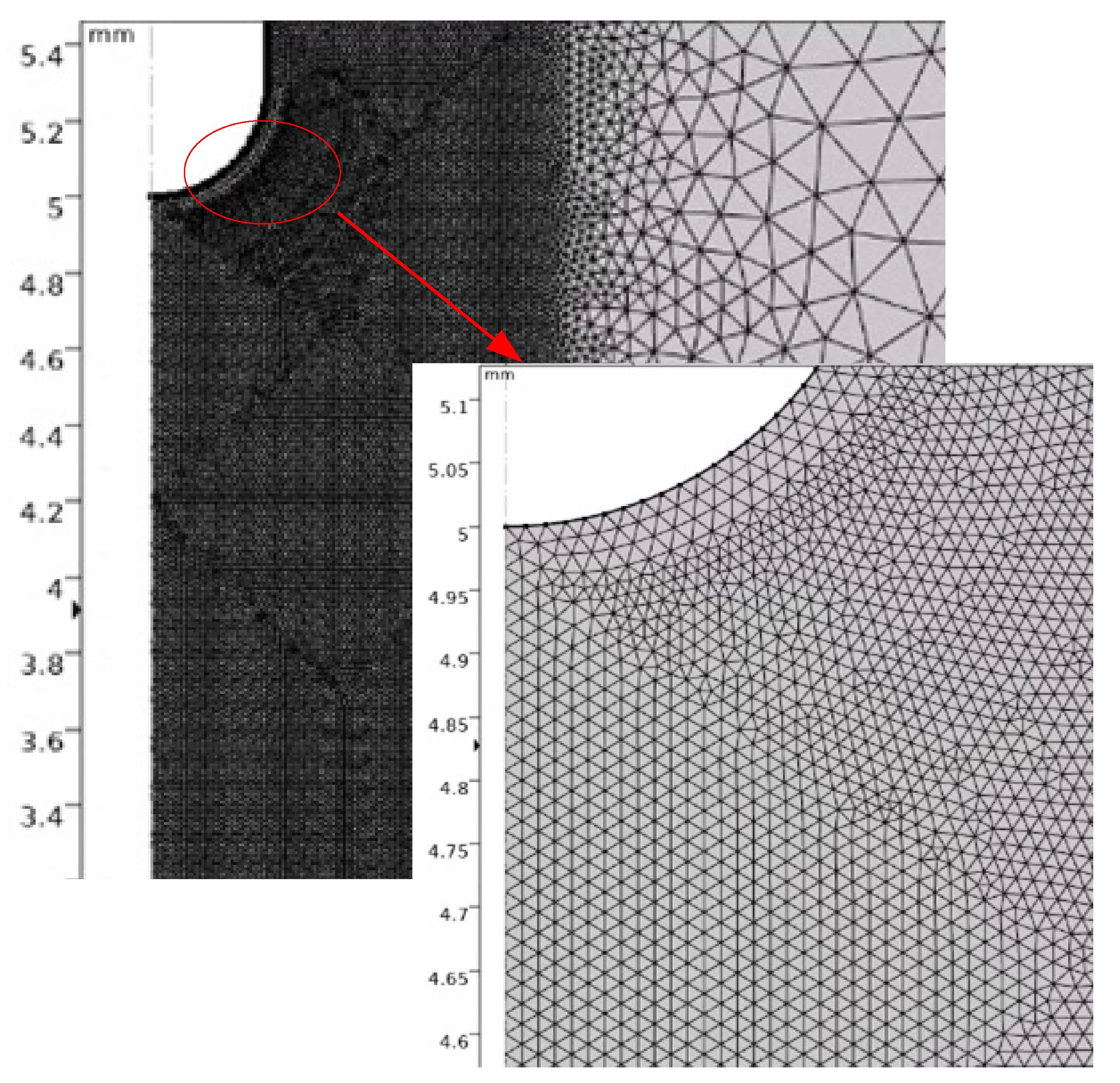
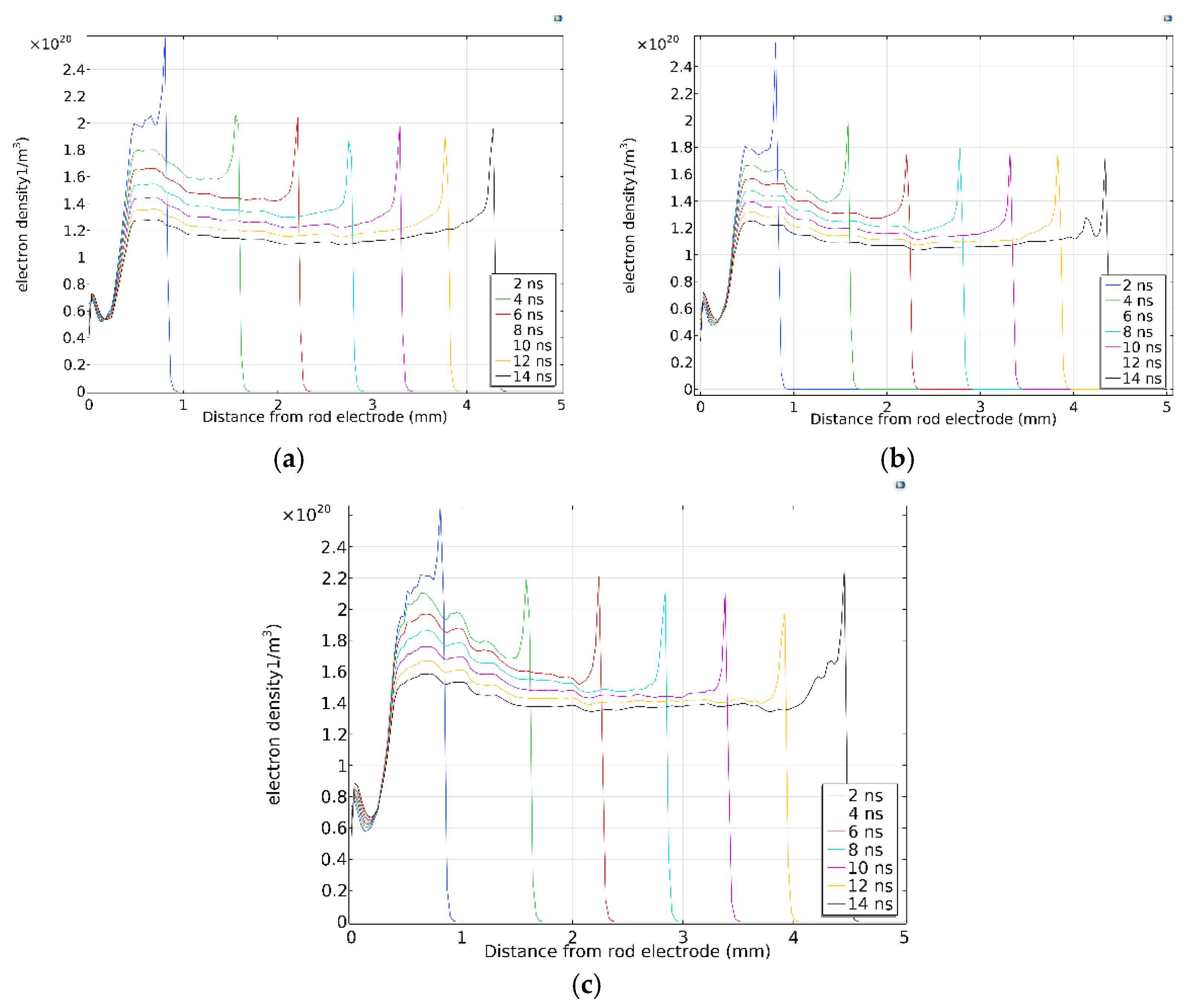
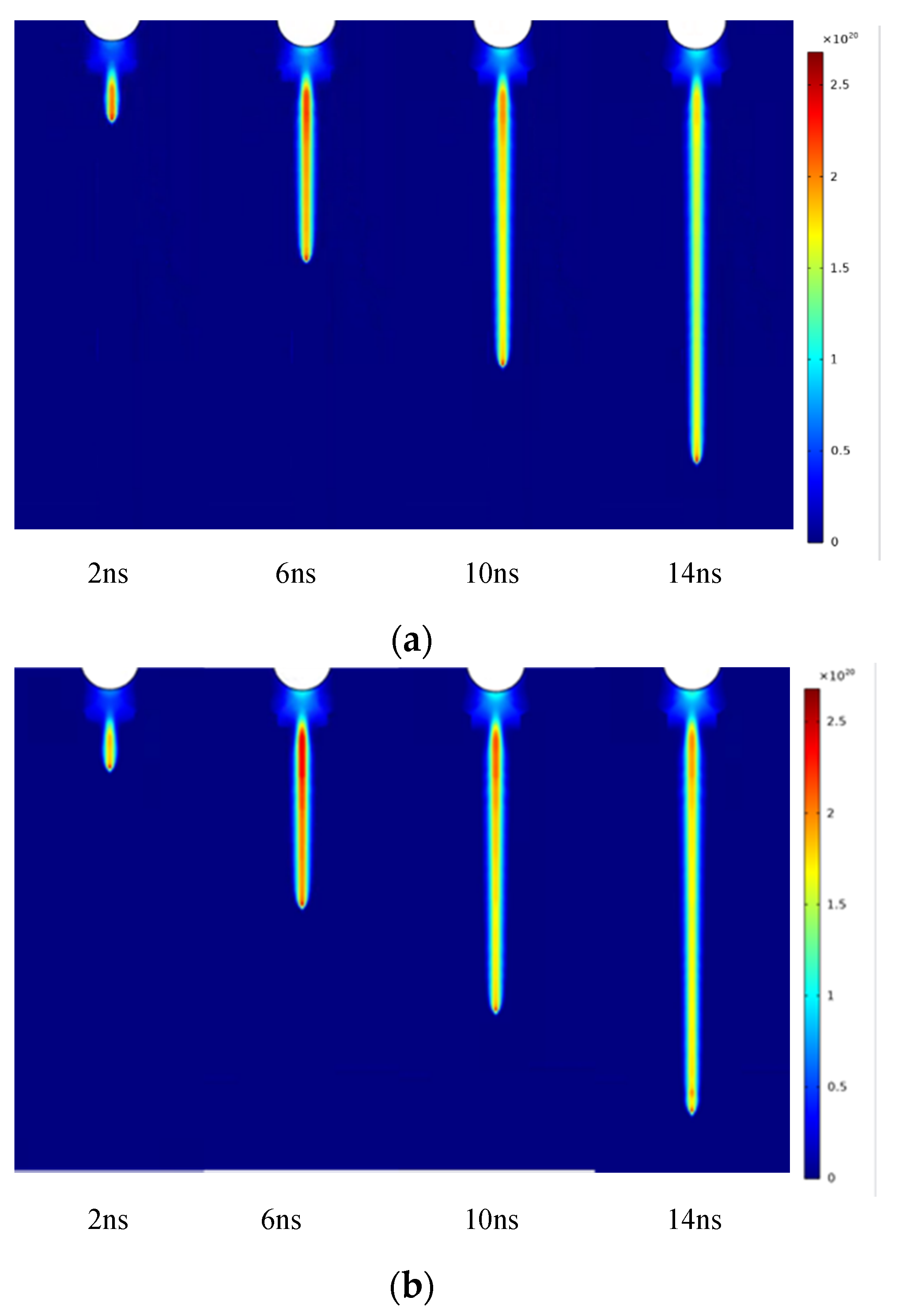




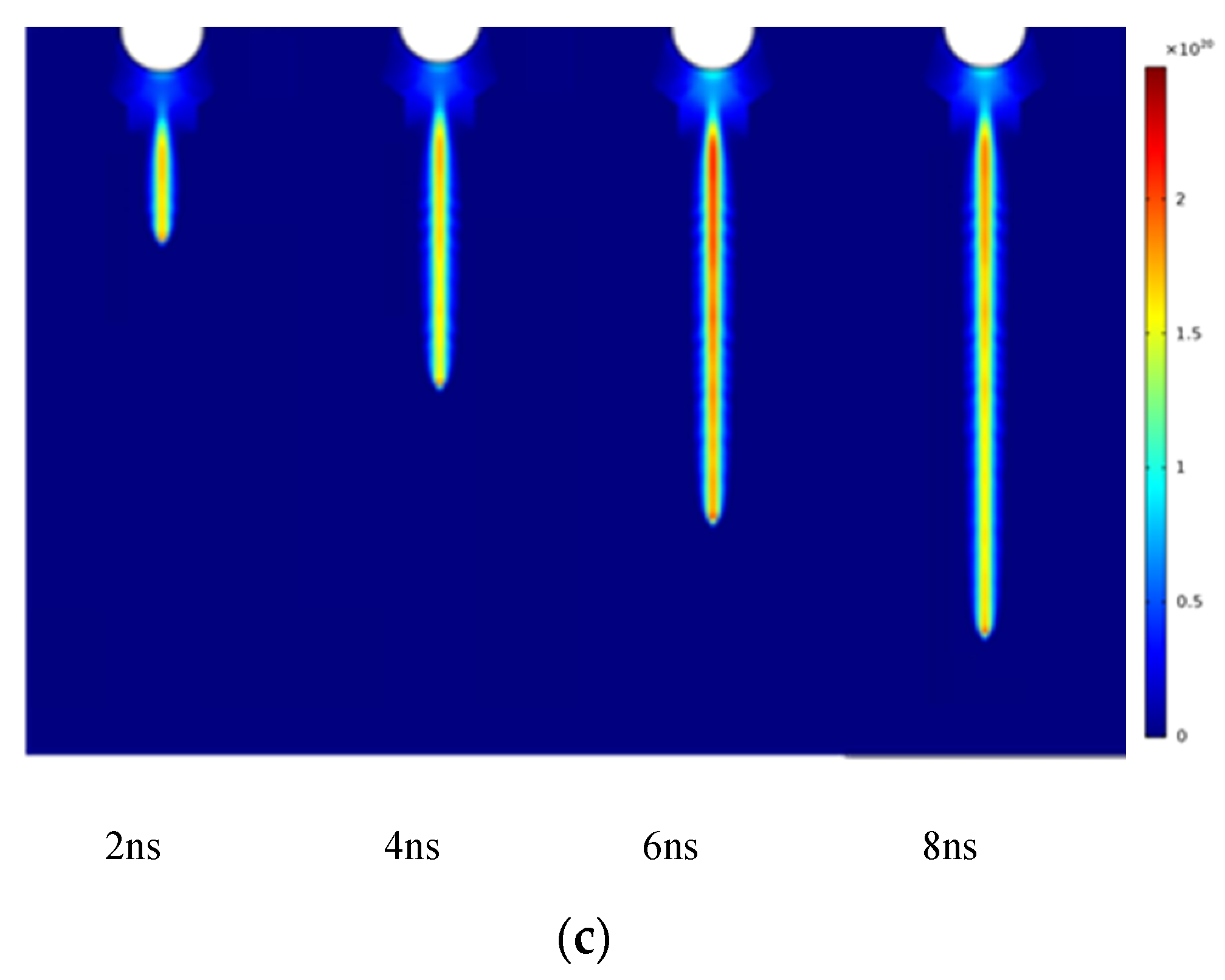
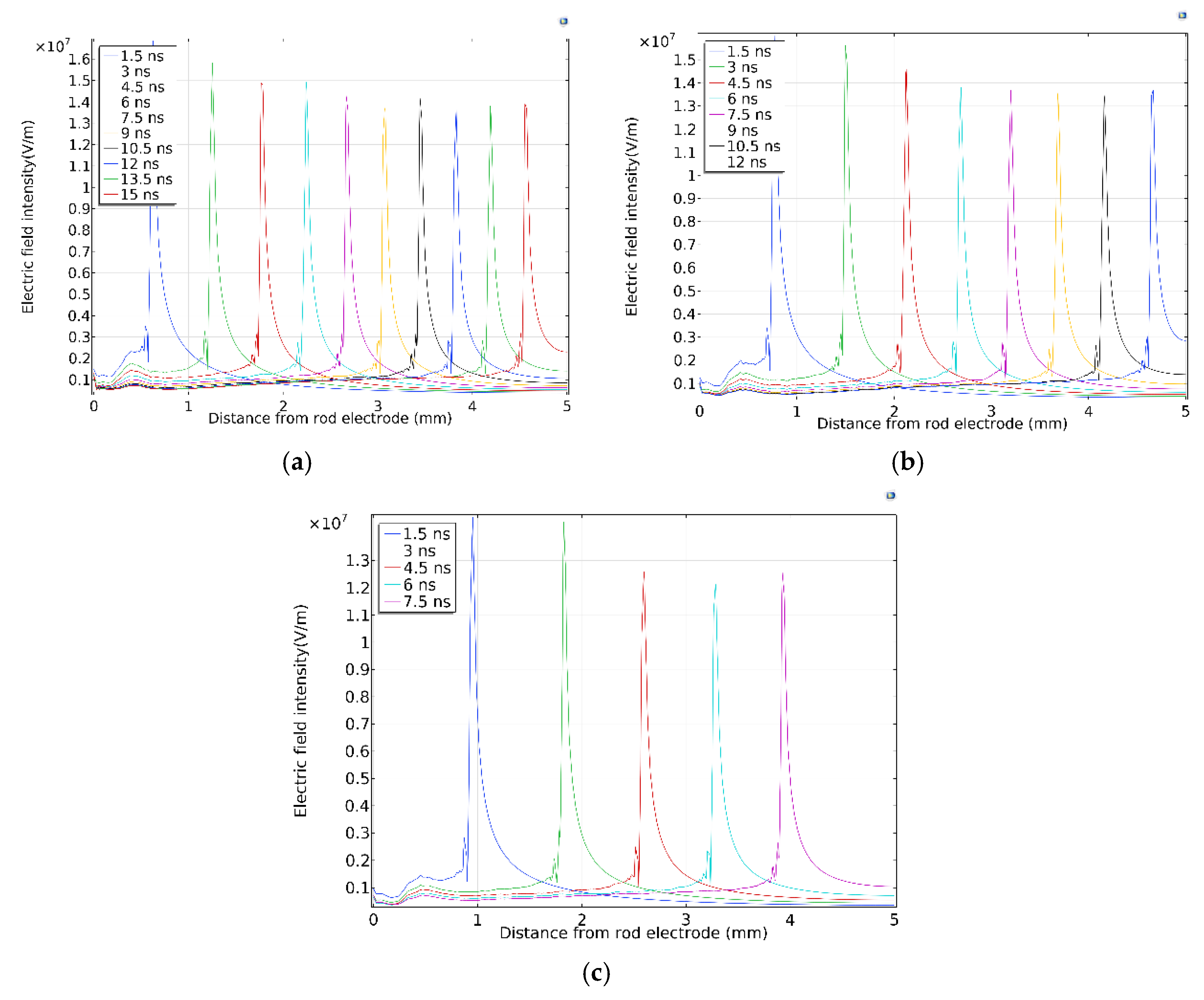
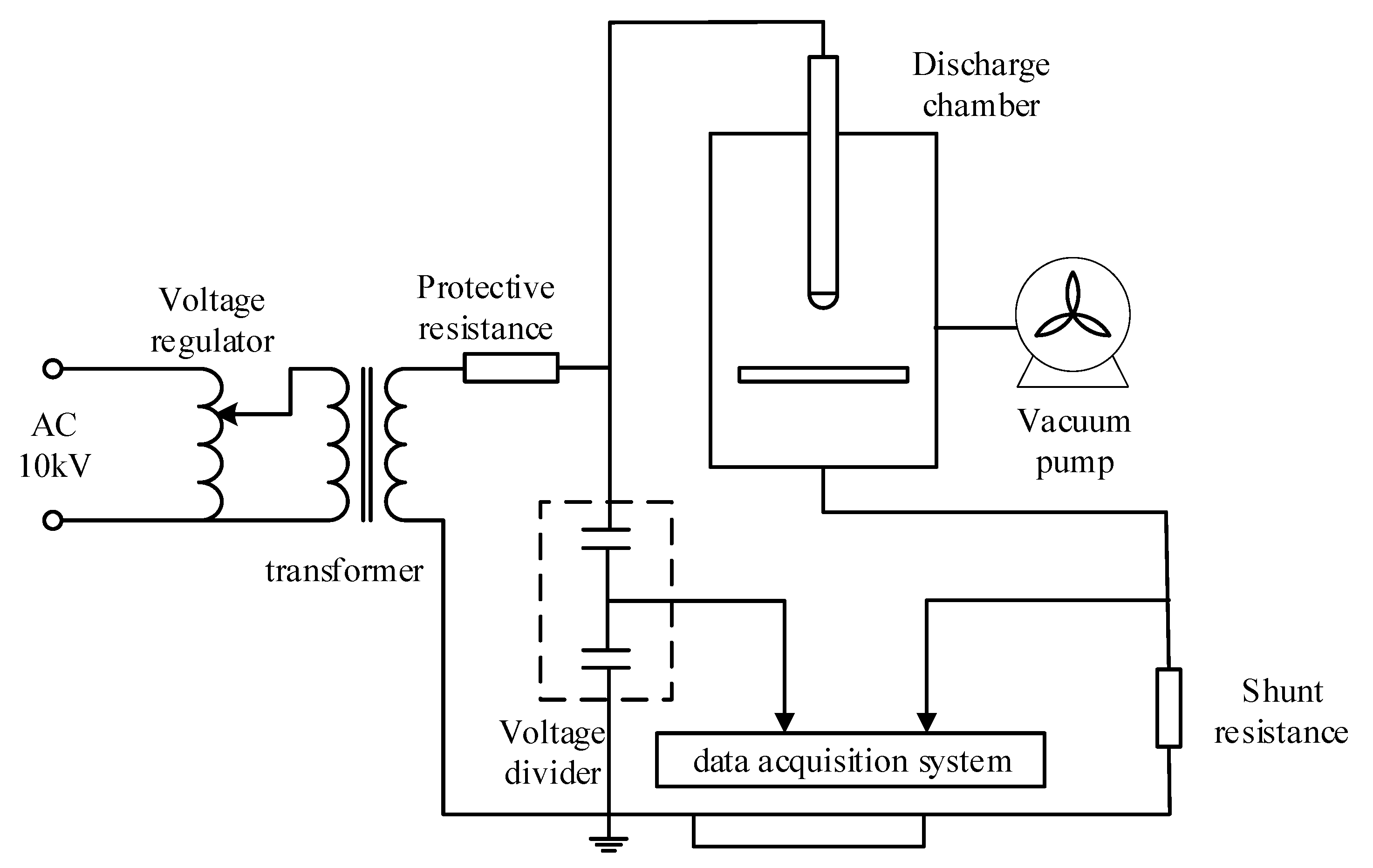
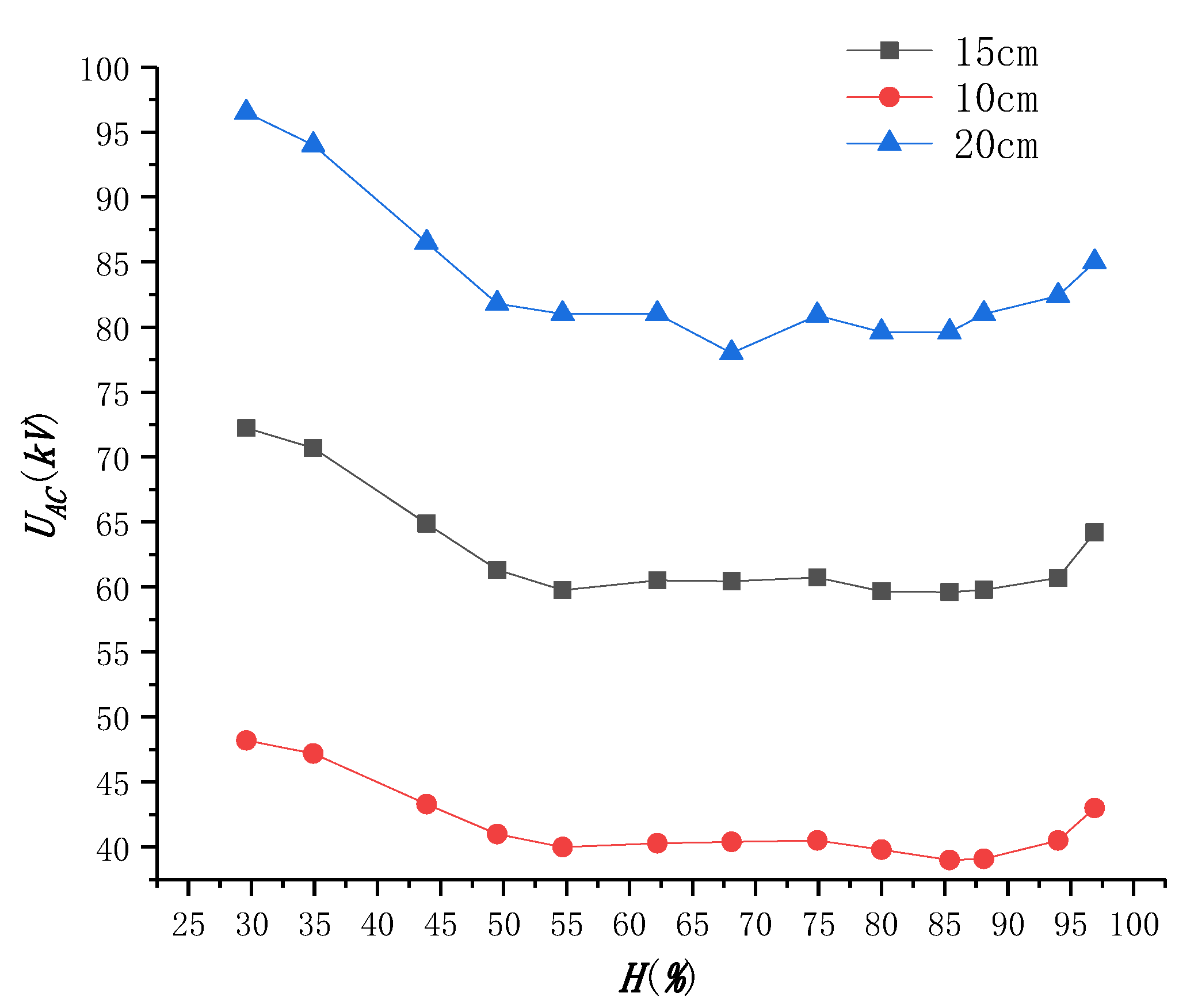

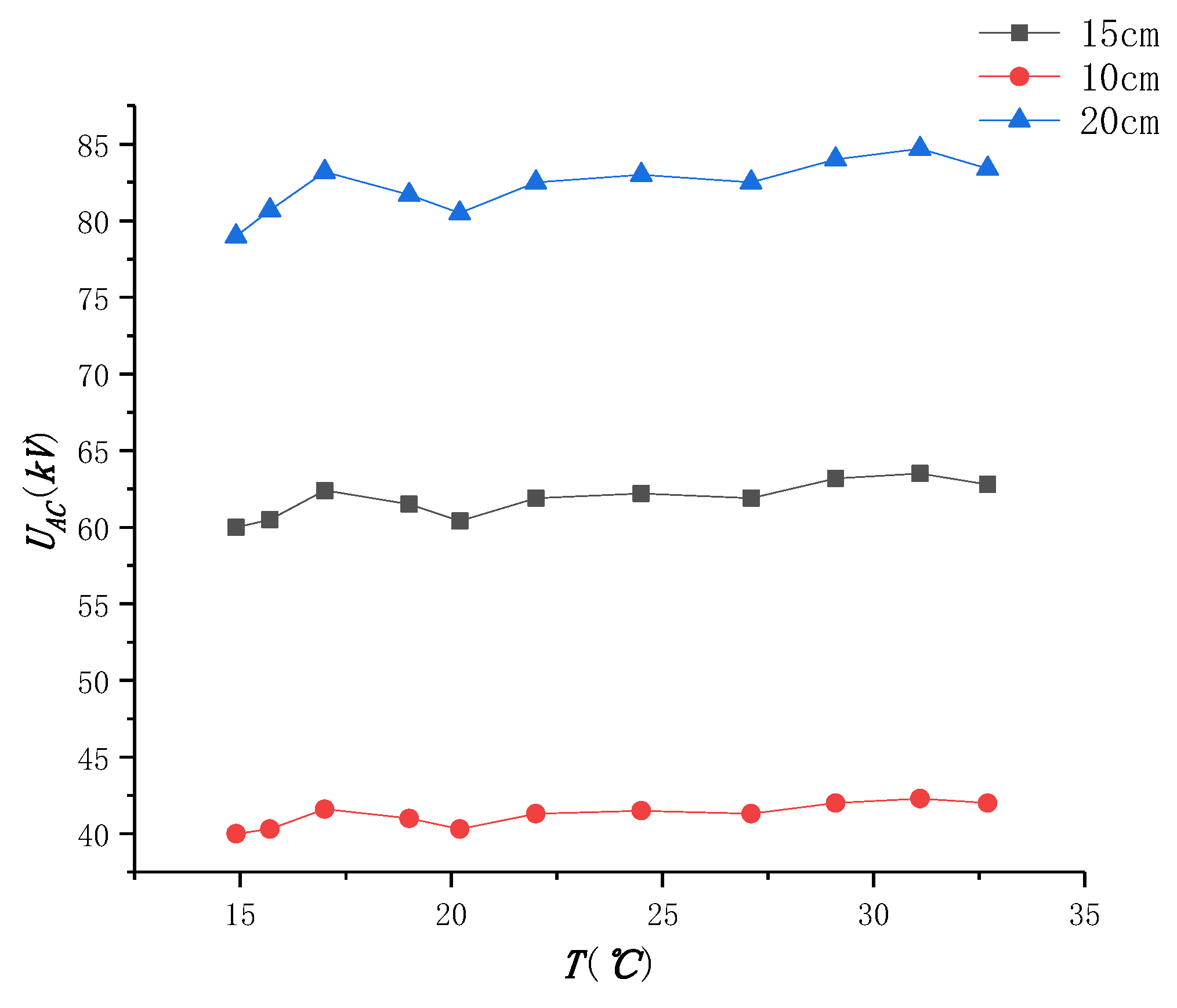
| Parameter | Expression | Scope of Use |
|---|---|---|
| αd (cm−1) | 3.9pexp(−213/(E/p)) | E/p < 108 |
| 14.5pexp(−316/(E/p)) | E/p ≥ 108 | |
| ηd (cm−1) | max{4.47/(E/p), 4.47 × 10−3(E/p)2} | E/p < 10 |
| 4.47 × 10−3 (E/p)2 | 10 < E/p < 50 | |
| 1.58 (E/p)0.5 | 50 < E/p < 90 | |
| 142/(E/p)0.5 | E/p < 90 | |
| μe (cm2V−1s−1) | 2.9 × 105/p | —— |
| μp (cm2V−1s−1) | 1.43 × 103/p | —— |
| μn (cm2V−1s−1) | −3.3 × 103/p | —— |
| βep (cm3s−1) | 1 × 10−7 | —— |
| De (cm2s−1) | DeT = 0.035 Eµμe/p; DeL = 1800 | —— |
| Dn (cm2s−1) | (cm2s−1) | —— |
| Dp (cm2s−1) | 0.046 | —— |
Publisher’s Note: MDPI stays neutral with regard to jurisdictional claims in published maps and institutional affiliations. |
© 2022 by the authors. Licensee MDPI, Basel, Switzerland. This article is an open access article distributed under the terms and conditions of the Creative Commons Attribution (CC BY) license (https://creativecommons.org/licenses/by/4.0/).
Share and Cite
Ren, X.; Jiang, X.; Yang, G.; Huang, Y.; Wu, J.; Yang, Z. Effect of Environmental Parameters on Streamer Discharge in Short Air Gap between Rod and Plate. Energies 2022, 15, 817. https://doi.org/10.3390/en15030817
Ren X, Jiang X, Yang G, Huang Y, Wu J, Yang Z. Effect of Environmental Parameters on Streamer Discharge in Short Air Gap between Rod and Plate. Energies. 2022; 15(3):817. https://doi.org/10.3390/en15030817
Chicago/Turabian StyleRen, Xiaodong, Xingliang Jiang, Guolin Yang, Yafei Huang, Jianguo Wu, and Zhongyi Yang. 2022. "Effect of Environmental Parameters on Streamer Discharge in Short Air Gap between Rod and Plate" Energies 15, no. 3: 817. https://doi.org/10.3390/en15030817





